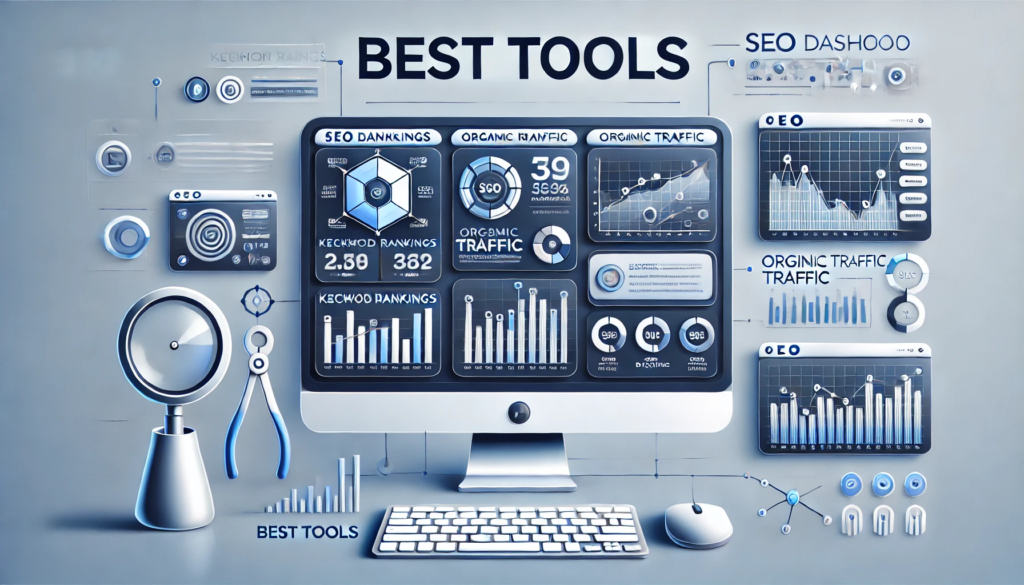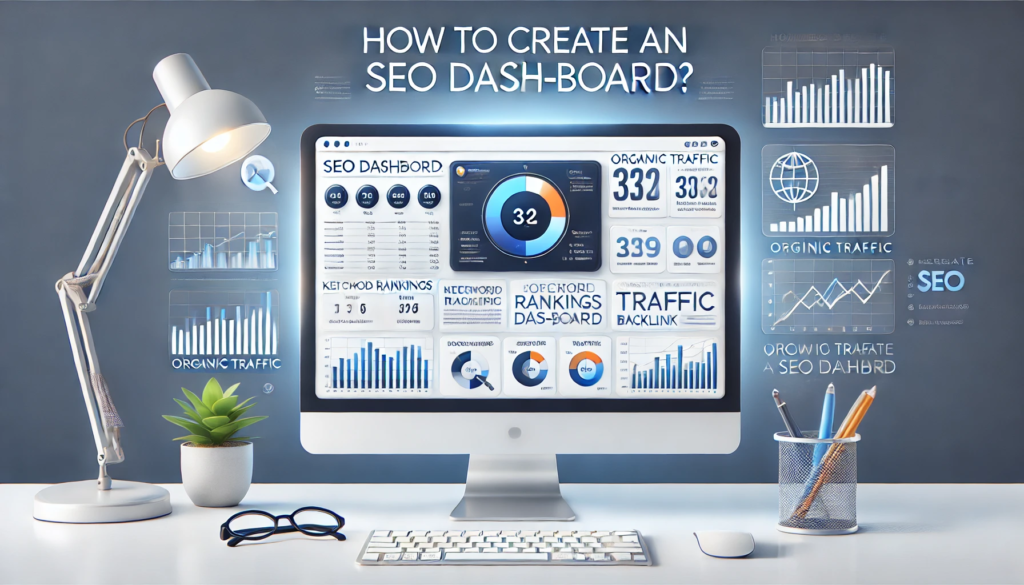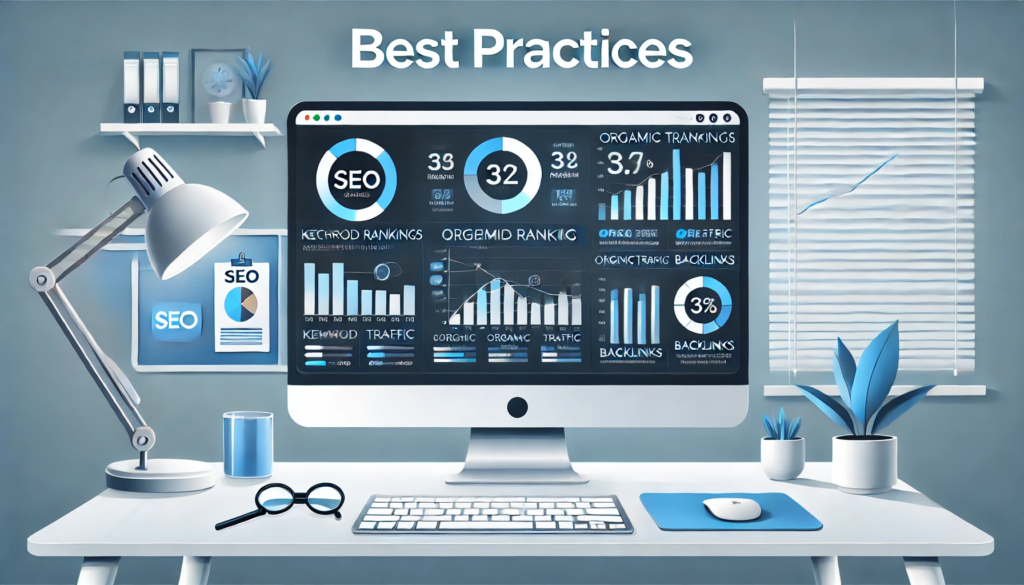
Creating an SEO dashboard is a critical step for anyone looking to optimise their website’s performance and understand the impact of their SEO efforts. An SEO dashboard provides a comprehensive view of key metrics, helping you track progress, identify trends, and make informed decisions. In this guide, we will explore the knowledge and tools to build an effective SEO dashboard that will empower you to monitor your website’s performance and improve your SEO strategy. Let’s dive into the process of how to create an SEO dashboard and unlock the full potential of your SEO efforts.
What is an SEO Dashboard?

An SEO dashboard is a centralised tool or interface that provides a comprehensive overview of a website’s search engine optimisation (SEO) performance. It consolidates various metrics and data points related to SEO activities, allowing users to monitor, analyse, and optimise their website’s visibility and ranking on search engines like Google. Here are the key components and features typically found in an SEO dashboard:
- Traffic Analysis
Shows the amount of organic traffic coming to the website, including metrics like total visits, unique visitors, and bounce rate.
- Keyword Rankings
Displays the rankings of targeted keywords, showing how they perform over time and their positions on search engine results pages (SERPs).
- Backlink Profile
Provides information on the number and quality of backlinks pointing to the website, including new and lost links.
- On-Page SEO Metrics
Monitors various on-page factors like meta tags, header tags, content quality, and keyword usage.
- Technical SEO
Tracks technical aspects of the website, such as site speed, mobile-friendliness, crawl errors, and indexability.
- Competitor Analysis
Compares the website’s SEO performance against competitors, highlighting strengths and areas for improvement.
- Content Performance
Analyses the effectiveness of content on the website, including page views, time on page, and engagement metrics.
- Social Media Integration
Tracks social media metrics that may influence SEO, such as shares, likes, and comments.
- Customisable Reports
Allows users to create custom reports based on specific metrics and time frames, facilitating easy sharing with stakeholders.
- Alerts and Notifications
Provides alerts for significant changes or issues, such as sudden drops in rankings or traffic spikes.
Why Do You Need an SEO Dashboard?

An SEO dashboard is crucial for several reasons, as it provides a streamlined and efficient way to manage and optimise a website’s search engine performance. Here are the key benefits:
- Centralised Data Management
- Easy Access: Consolidate all SEO data in one place for quick access.
- Streamlined Analysis: Simplify the analysis of multiple metrics without switching between tools.
- Real-Time Insights
- Up-to-date Information: Get real-time updates on SEO performance.
- Immediate Actions: React quickly to changes and trends in your SEO data.
- Performance Tracking
- Monitor KPIs: Track key performance indicators like organic traffic, keyword rankings, and backlinks.
- Identify Trends: Spot positive or negative trends early to adjust strategies accordingly.
- Customised Reporting
- Tailored Dashboards: Customise your dashboard to highlight the most relevant metrics.
- Shareable Reports: Easily generate and share reports with stakeholders.
- Competitive Analysis
- Benchmarking: Compare your SEO performance against competitors.
- Opportunity Identification: Identify new opportunities by analysing competitor strategies.
- Efficiency and Productivity
- Save Time: Automate data collection and reporting processes.
- Focus on Strategy: Spend more time on strategic planning and less on data gathering.
- Improved Decision Making
- Data-Driven Choices: Make informed decisions based on comprehensive SEO data.
- Optimise Efforts: Allocate resources effectively to areas that need improvement.
What Are the Best Tools for Building an SEO Dashboard?

Creating an effective SEO dashboard requires the right tools to monitor and analyse your website’s performance. Here are some of the best tools to consider:
- Google Analytics:
- Tracks website traffic and user behaviour.
- Provides insights into audience demographics and engagement.
- Google Search Console:
- Monitors website’s presence in Google search results.
- Identifies issues like crawl errors and security problems.
- SEMrush:
- Offers keyword research and competitive analysis.
- Tracks backlinks and organic search performance.
- Ahrefs:
- Analyses backlinks and competitor SEO strategies.
- Tracks keyword rankings and site audits.
- Moz Pro:
- Provides keyword research and site audits.
- Tracks search visibility and keyword performance.
- Screaming Frog SEO Spider:
- Crawls websites for SEO issues.
- Identifies broken links, duplicate content, and more.
- Google Data Studio:
- Visualises data from multiple sources.
- Creates customisable and interactive reports.
- Supermetrics:
- Pulls data from various marketing platforms.
- Integrates with Google Data Studio for detailed reporting.
How to Create an SEO Dashboard?

Here are the step-by-step guide to creating an SEO dashboard:
Step 1: Define Your Goals
Start by defining the goals of your SEO dashboard. What do you want to achieve? Common goals include:
- Tracking Organic Traffic: Monitor how your SEO efforts impact the number of visitors from search engines.
- Monitoring Keyword Rankings: See how your target keywords perform over time.
- Analysing Backlinks: Understand your backlink profile and identify opportunities for improvement.
- Improving Site Speed: Track page load times to enhance user experience.
Step 2: Choose Your Tools
Select the tools that will provide the data you need. For example:
- Google Analytics: For tracking traffic and user behaviour.
- Google Search Console: For keyword rankings and technical issues.
- Ahrefs or SEMrush: This is for backlinks and keyword research.
Step 3: Set Up Data Sources
Connect your chosen tools to your dashboard platform. For example, if you’re using Google Data Studio:
- Sign In to Data Studio: Go to Google Data Studio and sign in with your Google account.
- Create a New Report: Click the “Create” button and select “Report”.
- Add Data Sources: Click “Add Data” and select your data sources (e.g., Google Analytics, Google Search Console).
Step 4: Design Your Dashboard
Designing your dashboard involves choosing the right visualisations and layout. Here are some tips:
- Use Clear Titles: Label each section clearly (e.g., “Organic Traffic”, “Keyword Rankings”).
- Choose Appropriate Visualisations: Use line charts for trends, bar charts for comparisons, and tables for detailed data.
- Organise Logically: Group related metrics together (e.g., all traffic-related metrics in one section).
Step 5: Add Key Metrics
Now, add the key metrics to your dashboard. Here’s how to do it in Google Data Studio:
- Add a Chart: Click “Add a Chart” and choose the type of chart you want (e.g., line chart, bar chart).
- Select Data Source: Choose the data source for the chart (e.g., Google Analytics).
- Configure Metrics: Select the metric you want to display (e.g., “Organic Traffic”, “Bounce Rate”).
- Customise Appearance: Adjust the chart’s appearance (e.g., colours, labels).
Step 6: Customise and Optimise
Customise your dashboard to fit your needs:
- Adjust Timeframes: Allow users to change the date range (e.g., last 7 days, last 30 days).
- Add Filters: Enable filtering by dimensions such as country or device type.
- Use Calculated Fields: Create custom metrics by combining existing ones (e.g., Conversion Rate = Conversions / Sessions).
Step 7: Share Your Dashboard
Once your dashboard is set up, share it with stakeholders:
- Set Permissions: Choose who can view or edit the dashboard.
- Send Links: Share a link to the dashboard.
- Schedule Reports: Set up automated email reports with snapshots of the dashboard.
What Are the Best Practices for Maintaining Your SEO Dashboard?

- Regularly Update Data Sources
Ensure your data sources are always up to date. For example, regularly check that your Google Analytics and Search Console accounts are properly connected.
- Monitor Key Metrics
Keep an eye on your key metrics to quickly spot any changes or issues. Set up alerts for significant changes in traffic or rankings.
- Review and Optimise
Periodically review your dashboard and make improvements. For example, add new metrics as your SEO strategy evolves, or remove metrics that are no longer relevant.
- Use Insights for Action
Use the insights from your dashboard to make informed decisions. For example, if you notice a drop in organic traffic, investigate the cause and adjust your strategy accordingly.
What Are Some Advanced Tips for Creating an SEO Dashboard?

- Combine Data from Multiple Sources
Integrate data from different tools to get a comprehensive view of your SEO performance. For example, combine data from Google Analytics, Google Search Console, and Ahrefs in one dashboard.
- Use Custom Segments
Create custom segments to analyse specific groups of users. For example, create segments for users from different countries or users who visit a specific page.
- Track Competitor Performance
Add competitor data to your dashboard to see how you compare. For example, use tools like SEMrush or Ahrefs to track your competitors’ keyword rankings and backlinks.
- Automate Data Collection
Use automation to save time and ensure accuracy. For example, set up automated data imports from your SEO tools to your dashboard.
Conclusion
Creating an SEO dashboard is a powerful way to monitor and optimise your website’s performance. By following this guide, you can build a customised dashboard that tracks key metrics, identifies issues, and helps you make data-driven decisions. Remember to regularly update and review your dashboard to keep it relevant and useful. With the right tools and a clear plan, you’ll have an effective SEO dashboard that supports your SEO strategy and helps you achieve your goals.








No Comments